PS II Subunit P in Lilium pumilum (LpPsbP) Confers Saline-Alkali Resistance to the Plant by Scavenging ROS
Abstract
:1. Introduction
2. Results
2.1. Cloning of Open Reading Frame of LpPsbP Gene
2.2. Genetic Relationship between PsbP of L.pumilum and PsbP of Other Species
2.3. Expression Characteristics of LpPsbP Gene in the Leaves of L. pumilum after Stress Treatment
2.4. Optimization Conditions for Induction and Purification of Recombinant pGEX-LpPsbP
2.5. Resistance Analysis of Bacterial Solution Expressing LpPsbP Protein under Different Saline-Alkali Stresses
2.6. Gene Expression Analysis of pBI121-LpPsbP Overexpressing Tobaccos
2.7. Phenotypic Analysis of Tobacco with pBI121-LpPsbP Overexpression under Saline-Alkali Stress
2.7.1. Effect of Salt Stress on Seed Germination
2.7.2. Analysis of Seedling Resistance of Transgenic Plants under Salt Stress
2.7.3. Resistance Analysis of Transgenic Plants under Salt Stress
2.7.4. Stomatal Opening in WT and LpPsbP Transgenic Plants after Salt Stress
2.7.5. Assessment of O2− and H2O2 Accumulation in Tobacco by NBT and DAB Staining
2.8. Analysis of Physiological Indices of Tobacco under Saline-Alkali Stress
2.8.1. Relationship between LpPsbP Gene and Gas Exchange Parameters in Tobacco Leaves
2.8.2. Measurement of Chlorophyll Content of Tobacco under Different Salt Stresses
2.8.3. Measurement of O2− Content in Transgenic Plants
2.8.4. Measurement of H2O2 Content in Transgenic Plants
2.8.5. Measurement of Malondialdehyde Content Produced by Different Tobacco Lines under Salt Stress
2.9. Screening and Cotransformation Validation of cDNA Libraries
2.10. Luciferase Complementation Assay
2.11. Analysis of LpPsbP Promoter
3. Discussion
4. Materials and Methods
4.1. Cloning of LpPsbP Gene
4.2. Bioinformatics Analysis
4.3. Investigating the Expression Characteristics of LpPsbP Gene in the Leaves of L. pumilum after Stress Treatment
4.4. Construction of LpPsbP Protein Fusion Expression Vector and Optimization of Induced Expression Conditions
4.5. Resistance Analysis of LpPsbP Transgenic Tobacco under Saline Stress
4.6. Different Indices of Tobacco with pBI121-LpPsbP Overexpression under Saline-Alkali Stress
4.7. Screening and Validation of LpPsbP-Interacting Proteins
4.8. Cloning of the LpPsbP Promoter
5. Conclusions
Author Contributions
Funding
Institutional Review Board Statement
Informed Consent Statement
Data Availability Statement
Acknowledgments
Conflicts of Interest
Abbreviations
| ROS | Reactive oxygen species |
| JA | Jasmonic acid |
| PS II | Photosystem II |
| PsbP | PS II subunit P |
| IPTG | Isopropyl-beta-D-thiogalactopyranoside |
| GST | Glutathione S-transferase |
| OD | Optical density |
| NBT | Nitro-blue tetrazolium |
| DAB | Diaminobenzidine |
| MDA | Malondialdehyde |
| TBA | Thiobarbituric acid |
References
- Li, B. The scientific way of improvement and utilization of saline-alkali land in the new era. Agric. Compr. Dev. China 2022, 20, 8–9. [Google Scholar]
- Wang, Z.; Li, Q.; Li, X.; Song, C.; Zhang, G. Saline-alkali land management and countermeasures of sustainable agricultural development in Songnen Plain. Chin. J. Eco-Agric. 2004, 12, 166–168. [Google Scholar]
- Qi, X.; Wang, K.; Yang, L.; Deng, Z.; Sun, Z. The complete mitogenome sequence of the coral lily (Lilium pumilum) and the Lanzhou lily (Lilium davidii) in China. Open Life Sci. 2020, 15, 1060–1067. [Google Scholar] [CrossRef] [PubMed]
- Lei, F.; Zhang, H.; Long, Y.; Deng, S.; Zhang, A. Characteristics and phylogenetic analysis of the complete chloroplast genome of Lilium concolor Salisb. (Liliaceae) from Jilin, China. Mitochondrial DNA B. Resour. 2022, 7, 30–31. [Google Scholar] [CrossRef] [PubMed]
- Jin, J.; Liu, H.; Zhong, C.; Xie, J.; Qin, Y.; Liang, X.; Chen, L.; Cai, P.; Zhang, S. Characterization of the complete chloroplast genome of an endangered ornamental and medicinal plant Lilium pumilum. Mitochondrial DNA B. Resour. 2020, 5, 1111–1112. [Google Scholar] [CrossRef] [PubMed]
- Tatli, O.; Sogutmaz Ozdemir, B.; Dinler Doganay, G. Time-dependent leaf proteome alterations of Brachypodium distachyon in response to drought stress. Plant Mol. Biol. 2017, 94, 609–623. [Google Scholar] [CrossRef]
- Mayfield, S.P.; Rahire, M.; Frank, G.; Zuber, H.; Rochaix, J.D. Expression of the nuclear gene encoding oxygen-evolving enhancer protein 2 is required for high levels of photosynthetic oxygen evolution in Chlamydomonas reinhardtii. Proc. Natl. Acad. Sci. USA 1987, 84, 749–753. [Google Scholar] [CrossRef] [PubMed]
- Ifuku, K.; Nakatsu, T.; Kato, H.; Sato, F. Crystal structure of the PsbP protein of photosystem II from Nicotiana tabacum. EMBO Rep. 2004, 5, 362–367. [Google Scholar] [CrossRef] [PubMed]
- Hu, J.; Aguirre, M.; Peto, C.; Alonso, J.; Ecker, J.; Chory, J. A role for peroxisomes in photomorphogenesis and development of Arabidopsis. Science 2002, 297, 405–409. [Google Scholar] [CrossRef]
- Yi, X.; Hargett, S.R.; Frankel, L.K.; Bricker, T.M. The effects of simultaneous RNAi suppression of PsbO and PsbP protein expression in photosystem II of Arabidopsis. Photosynth. Res. 2008, 98, 439–448. [Google Scholar] [CrossRef]
- Yang, D. Functional Analysis of Cotton PsbP Promoter. Master’s Thesis, Xinjiang Agricultural University, Xinjiang, China, 1 June 2010. [Google Scholar]
- Yu, M.; Huang, L.; Feng, N.; Zheng, D.; Zhao, J. Exogenous uniconazole enhances tolerance to chilling stress in mung beans (Vigna radiata L.) through cross talk among photosynthesis, antioxidant system, sucrose metabolism, and hormones. J. Plant Physiol. 2022, 276, 153772. [Google Scholar] [CrossRef] [PubMed]
- Yuan, L.; Zheng, Y.; Nie, L.; Zhang, L.; Wu, Y.; Zhu, S.; Hou, J.; Shan, G.L.; Liu, T.K.; Chen, G.; et al. Transcriptional profiling reveals changes in gene regulation and signaling transduction pathways during temperature stress in wucai (Brassica campestris L.). BMC Genom. 2021, 22, 687. [Google Scholar] [CrossRef] [PubMed]
- Vessal, S.; Arefian, M.; Siddique, K.H.M. Proteomic responses to progressive dehydration stress in leaves of chickpea seedlings. BMC Genom. 2020, 21, 523. [Google Scholar] [CrossRef] [PubMed]
- Lu, Y.; Li, Q.-Q.; Yang, Y.; Chen, Q.; Gao, X.; Xiao, J.-X. Comparative transcriptome analysis reveals positive effects of arbuscular mycorrhizal fungi inoculation on photosynthesis and high-pH tolerance in blueberry seedlings. Trees: Struct. Func. 2020, 34, 433–444. [Google Scholar]
- Amna, M.; Frank, V.B. Reactive oxygen species in plant development. Development 2018, 145, dev164376. [Google Scholar]
- Gómez, M.S.; Falcone Ferreyra, M.L.; Sheridan, M.L.; Paula, C. Arabidopsis E2Fc is required for the DNA damage response under UV-B radiation epistatically over the microRNA396 and independently of E2Fe. Plant Physiol. 2019, 97, 749–764. [Google Scholar]
- Xu, W. The Functions of MAPRs and Pollen Ole e 1 under Endoplasmic Reticulum Stress in Arabidopsis thaliana. Master’s Thesis, East China Normal University, Shanghai, China, 1 June 2020. [Google Scholar]
- Xu, C.; Heiko, H.; Hajime, W.; Miki, H.; Yu, B.; Chris, E.; Christoph, B. The pgp1 mutant locus of Arabidopsis encodes a phosphatidylglycerolphosphate synthase with impaired activity. Plant Physiol. 2002, 129, 594–604. [Google Scholar] [CrossRef]
- Takeshi, K.; Hiroki, T.; Mikiko, K.; Nanae, U.; Takashi, I.; Shingo, N.; Hiroo, F.; Keiko, S.; Hitoshi, S. Functional analyses of LONELY GUY cytokinin-activating enzymes reveal the importance of the direct activation pathway in Arabidopsis. Plant Cell 2009, 21, 3152–3169. [Google Scholar]
- Wang, W.; Tian, Z.; Su, X.; Yang, L.; Zhou, Y. Cloning and expression analysis of LpAGD14 from Lilium pumilum. Acta Prataculturae Sin. 2018, 27, 117–123. [Google Scholar]
- Anirban, B. Strawberries under salt stress: ALA and ROS to the rescue. Physio Plant. 2019, 167, 2–4. [Google Scholar]
- Kang, L.; Kim, H.S.; Kwon, Y.S.; Ke, Q.; Ji, C.Y.; Park, S.C.; Lee, H.S.; Deng, X.; Kwak, S.S. IbOr Regulates Photosynthesis under Heat Stress by Stabilizing IbPsbP in Sweetpotato. Front Plant Sci. 2017, 8, 989. [Google Scholar] [CrossRef]
- Cao, D.; Lu, J. The structure and function of forkhead (Fox) transcription factor family. Chin. Bull. Life Sci. 2006, 18, 491–496. [Google Scholar]
- Liu, R.; Chen, T.; Yin, X.; Xiang, G.; Peng, J.; Fu, Q.; Li, M.; Shang, B.; Ma, H.; Liu, G.; et al. A Plasmopara viticola RXLR effector targets a chloroplast protein PsbP to inhibit ROS production in grapevine. Plant J. 2021, 106, 1557–1570. [Google Scholar] [CrossRef] [PubMed]
- Hong, Y.; Wang, Z.; Liu, X.; Yao, J.; Kong, X.; Shi, H.; Zhu, J.-K. Two Chloroplast Proteins Negatively Regulate Plant Drought Resistance Through Separate Pathways. Plant Physiol. 2020, 182, 1007–1021. [Google Scholar] [CrossRef] [PubMed]
- Lv, G.; Zhou, J.; Yang, J.; Dingf, Q. ROS regulation of FOXO activity and its expression. J. Pharm. Res. 2019, 38, 286–289+310. [Google Scholar]
- Tothova, Z.; Kollipara, R.; Huntly, B.J.; Lee, B.H.; Castrillon, D.H.; Cullen, D.E.; McDowell, E.P.; Lazo-Kallanian, S.; Williams, I.R.; Sears, C.; et al. FoxOs are critical mediators of hematopoietic stem cell resistance to physiologic oxidative stress. Cell 2007, 128, 325–339. [Google Scholar] [CrossRef]
- Nogueira, V.; Park, Y.; Chen, C.-C.; Xu, P.-Z.; Chen, M.-L.; Tonic, I.; Unterman, T.; Hay, N. Akt Determines Replicative Senescence and Oxidative or Oncogenic Premature Senescence and Sensitizes Cells to Oxidative Apoptosis. Cancer Cell 2008, 14, 458–470. [Google Scholar] [CrossRef]
- Liu, X.; Greer, C.; Secombe, J. KDM5 interacts with Foxo to modulate cellular levels of oxidative stress. PLoS Genet. 2014, 10, e1004676. [Google Scholar] [CrossRef]
- Myers, R.J.; Fichman, Y.; Zandalinas, S.I.; Mittler, R. Jasmonic acid and salicylic acid modulate systemic reactive oxygen species signaling during stress responses. Plant Physiol. 2022, 184, 449. [Google Scholar] [CrossRef]
- Wang, C.; He, M.; Li, Y.; Jiang, C.; Tian, L.; Wang, Q. Comparative study on different detection methods of superoxide radicals in plant tissues. Environ. Chem. 2012, 31, 726–730. [Google Scholar]
- Gao, J. Experimental Guidance for Plant Physiology, 1st ed.; Higher Education Press: Beijing, China, 2006; pp. 210–211. [Google Scholar]
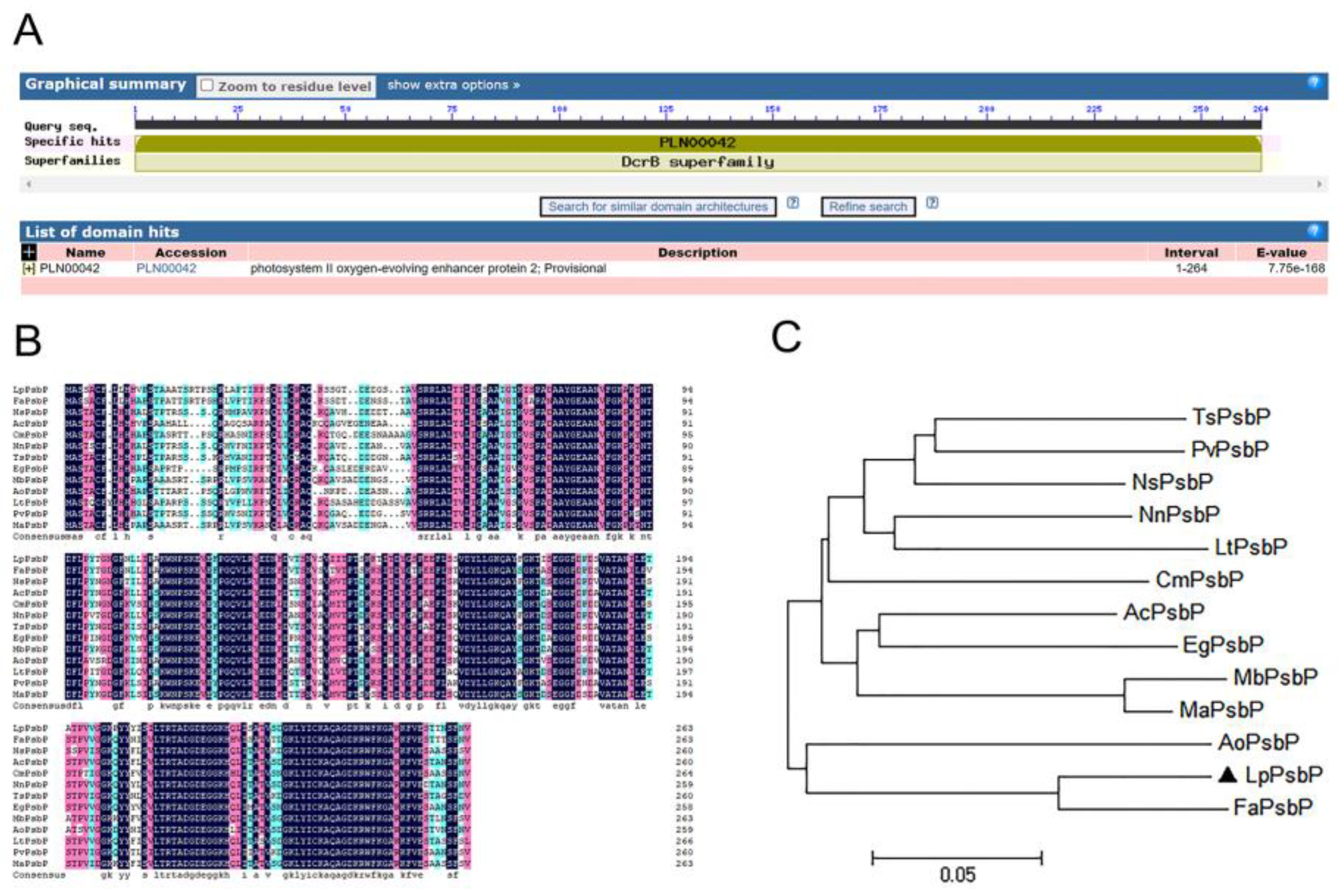
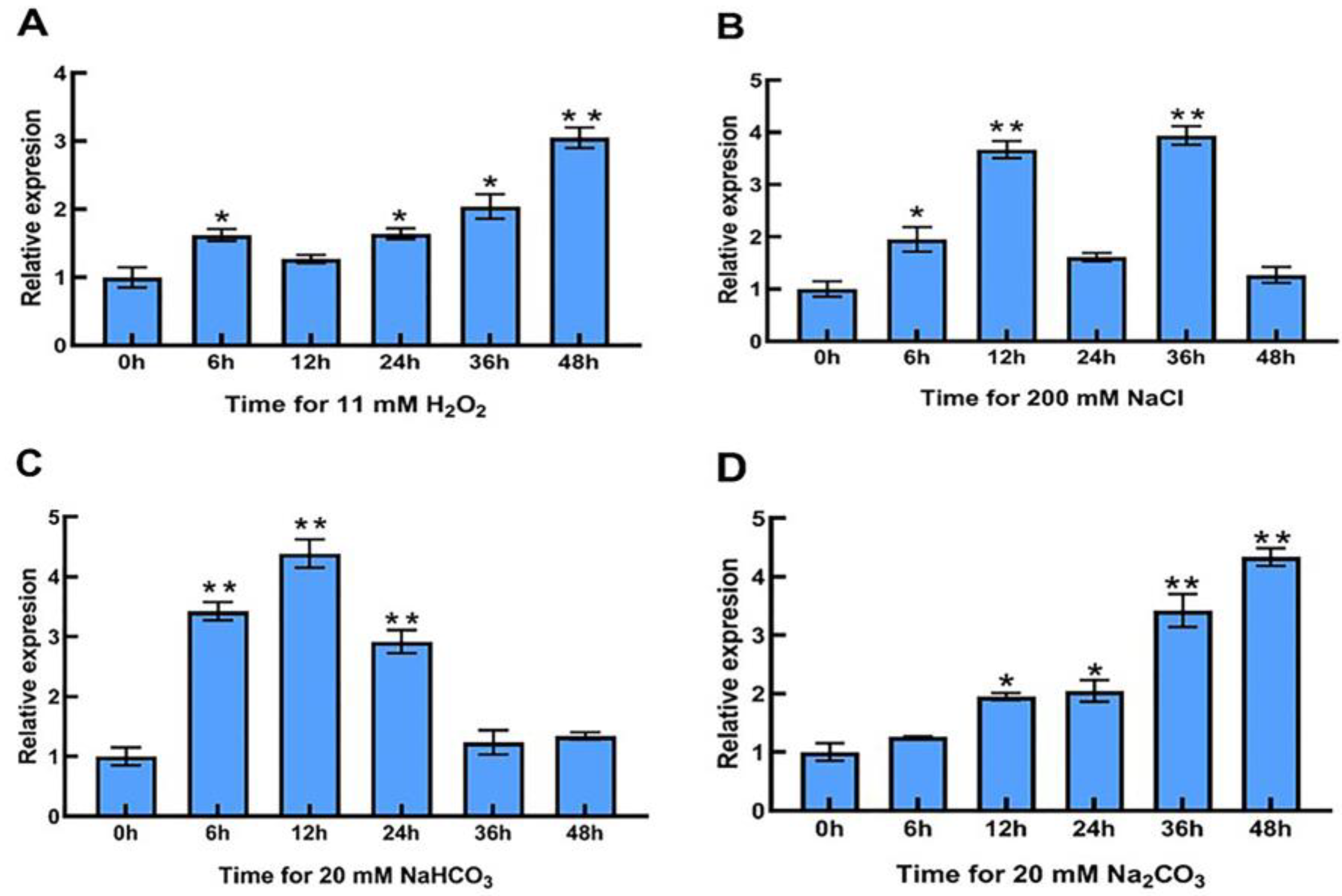
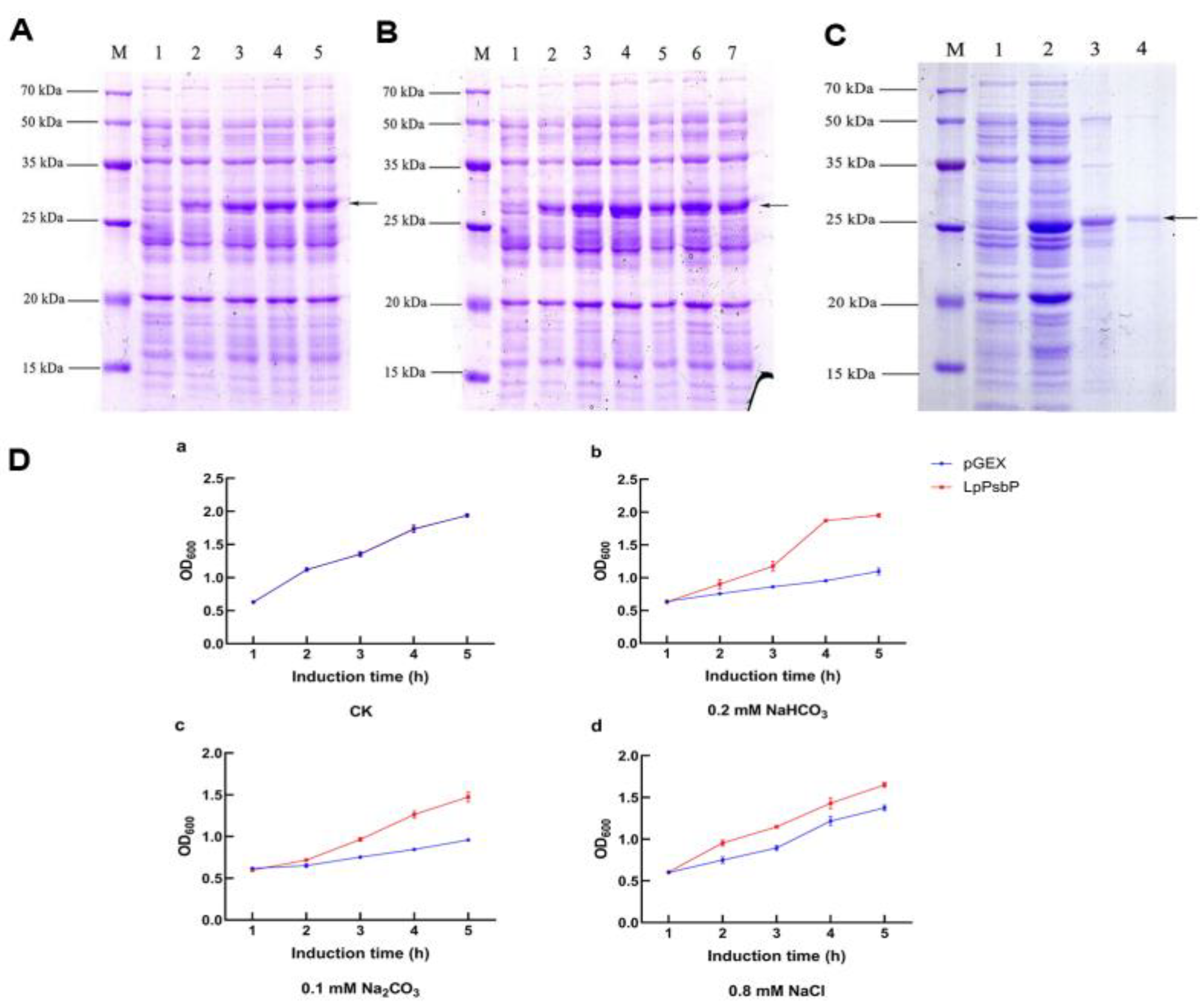
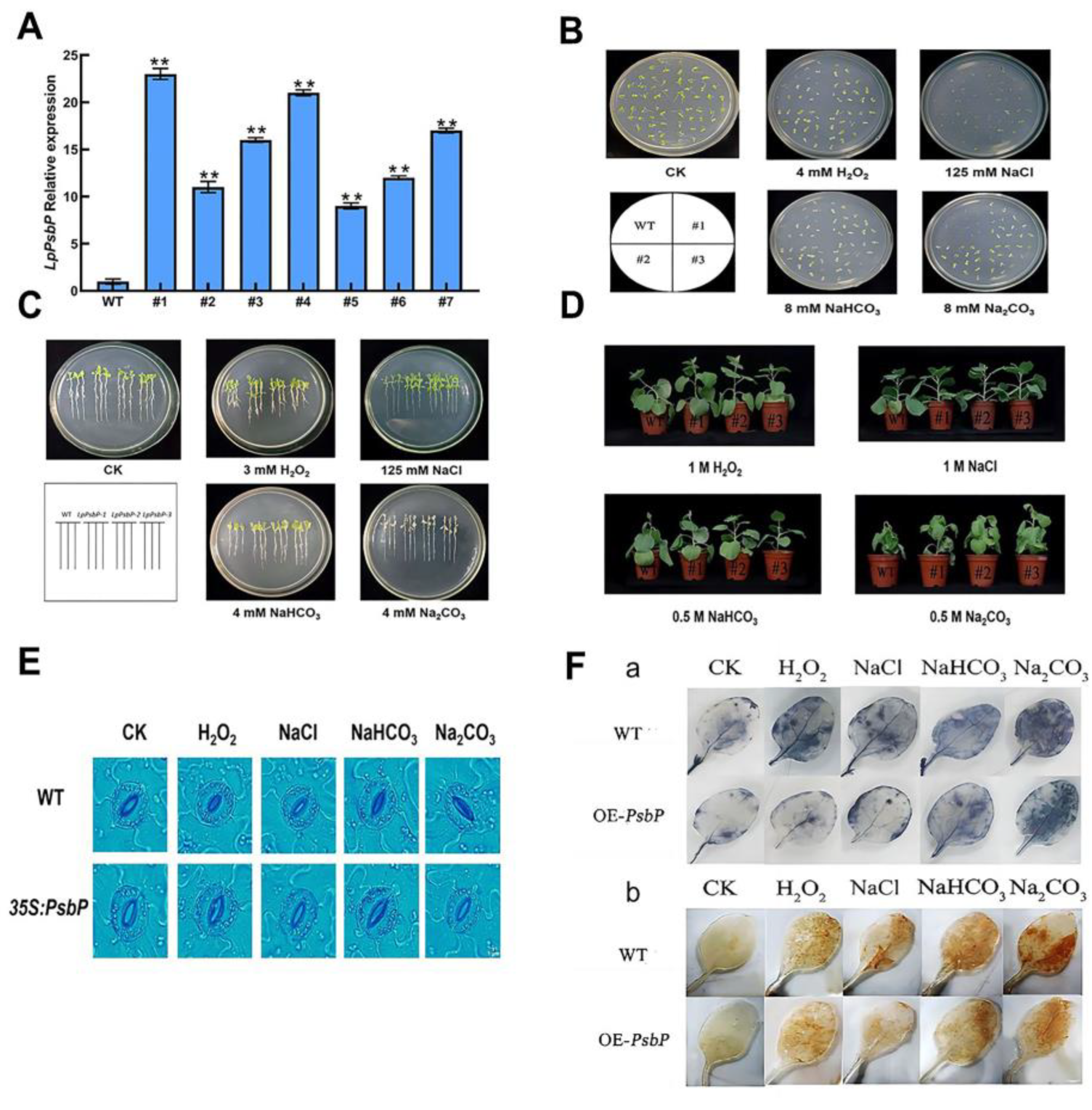

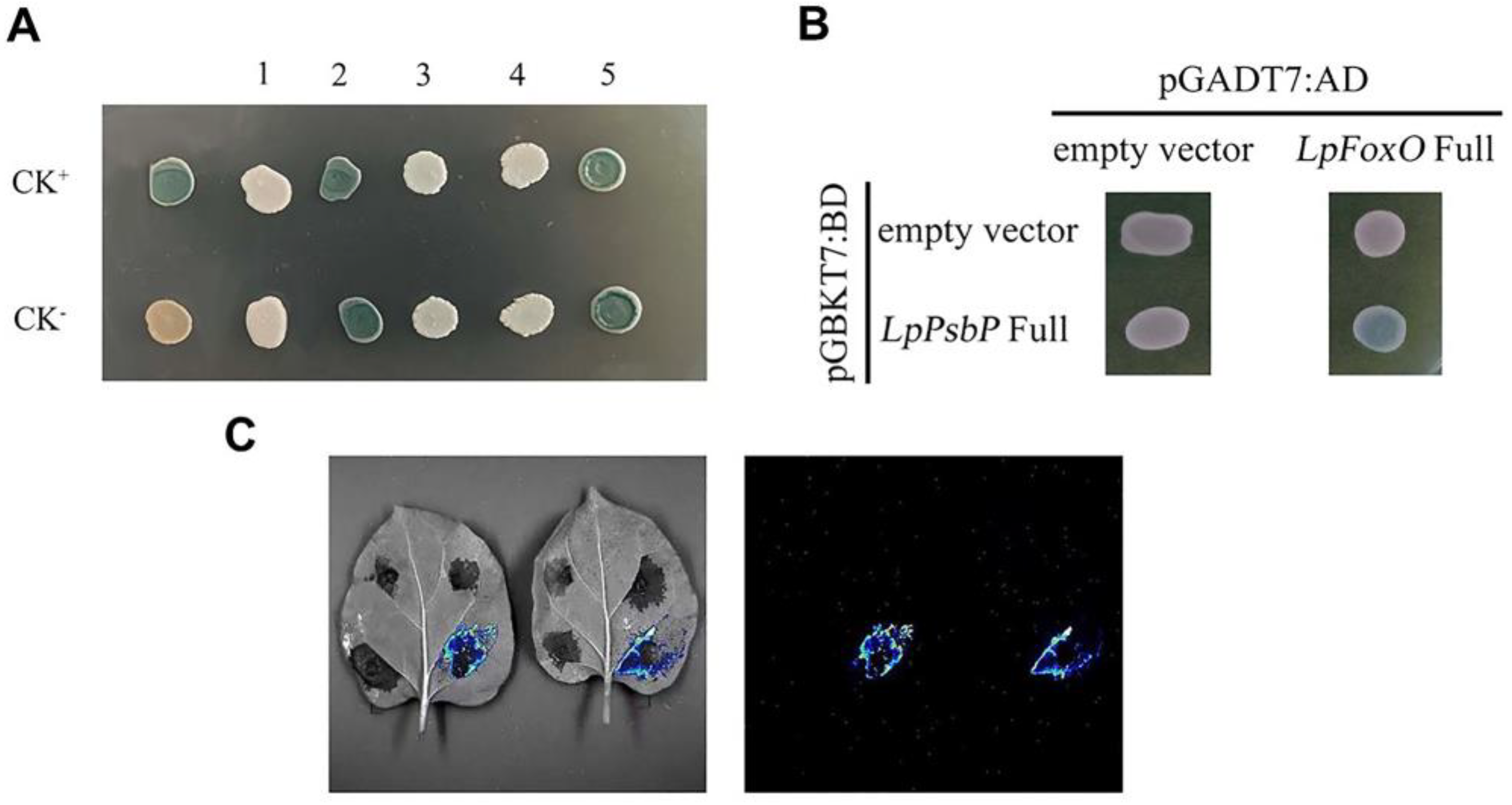

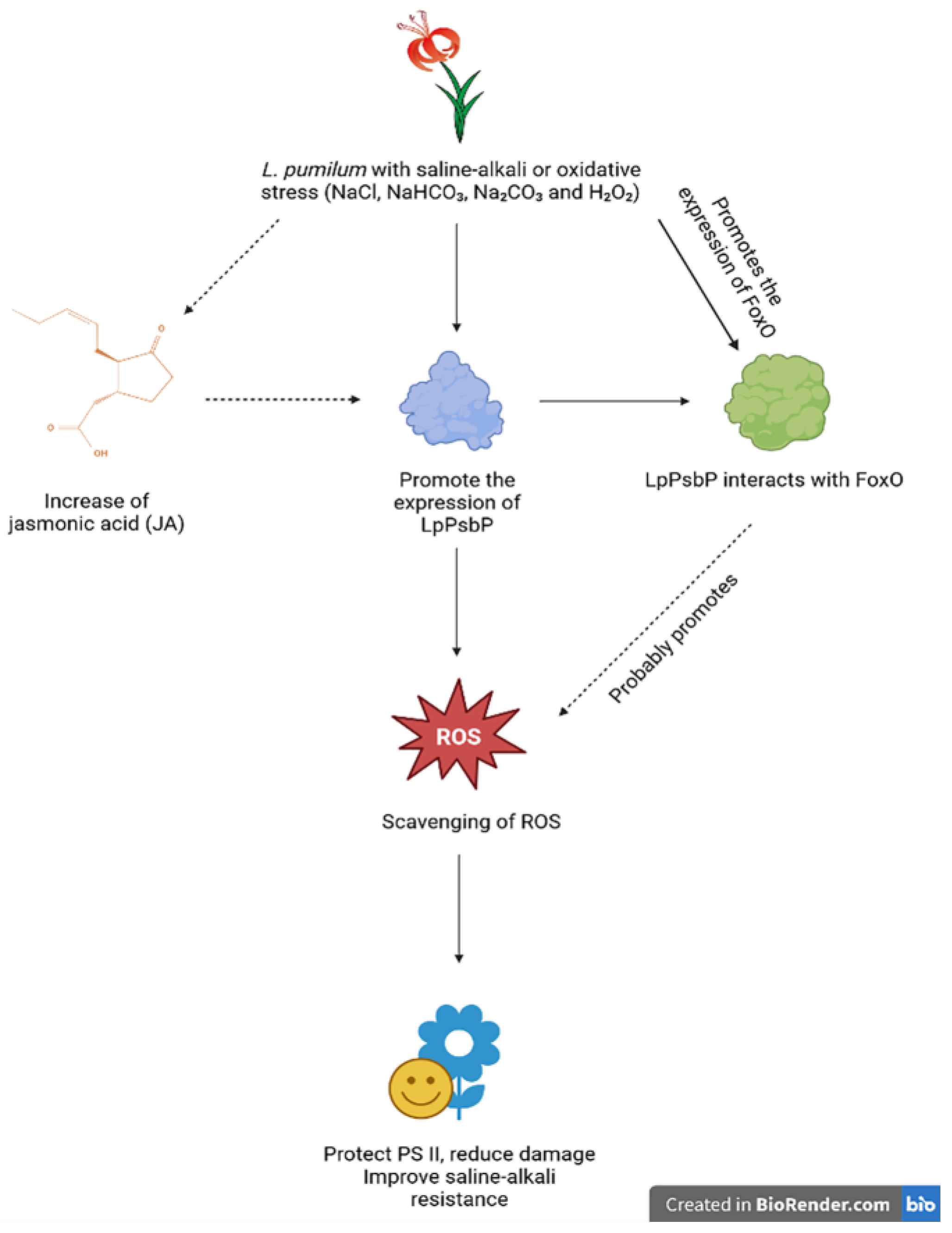
| Primer Name | Primer Sequence |
|---|---|
| LpPsbP-F | ATGGCCTCATCTGCATGC |
| LpPsbP-R | TCATGCAACATTGAAGGA |
| LpPsbP qPCR-F | CACCAACCATCAAGCCCTCT |
| LpPsbP qPCR-R | CCTGACCTGGGAACTCAACC |
| LpPsbP-BamH1-F | GGATCCATGGCCTCATCTGCAT |
| LpPsbP-Xho1-R | CTCGAGTCATGCAACATTGAAGGA |
| LpPsbP-Sal1-R | GTCGACTCATGCAACATTGAAGGA |
| LpFoxO-F | ATGTCGATTAGCCGGGCA |
| LpFoxO-R | TCATCTCCCAGCACAGTT |
| pGEX-LpPsbP-BamH1-F | GGATCCATGGCCTCATCTGCAT |
| LpPsbP SP1 | ATGGCAGCAGAGCCAATGAGGA |
| LpPsbP SP2 | TTCTGAGCCCGACAGATGAGCT |
| LpPsbP SP3 | ACATGGTGGAGGAGGAAGCATG |
| T7 | TAATACGACTCACTATAGGGC |
| 3′-AD | AGATGGTCACGATGCACAG |
| LpPsbP-SacI-F | GAGCTCATGGCATCGACAGC |
| LpPsbP-SalI-R | GTCGACAGCAACATTGAAGG |
| FoxO-BamHI-F | GGATCCATGTCGATTAGCCG |
| FoxO-SalI-R | GTCGACTCATCTCCCAGCAC |
| Protein Name | Functions | Reference |
|---|---|---|
| Winged-helix DNA-binding transcription factor family protein | Modulate DNA damage response through the regulation of SOG1 and ATR transcription level. | [17] |
| Pollen Ole e 1 allergen and extensin family protein | Response to salt stress by maintain the steady state of endoplasmic reticulum. | [18] |
| Phosphatidyl glycerol phosphate synthase 2 | Stabilizing photosynthetic membrane by producing phosphatidyl glycerol phosphate in order to maintain the stability of plant under Saline-Alkali stress. | [19] |
| Putative lysine decarboxylase family protein | Play an important role in direct activation pathway of cytokinesis. | [20] |
| ARF-GAP domain 13 | Release dormancy of plant stem by affecting the transport of vesicle. | [21] |
| Cis-Element | Motif (5′-3′) | Function | Frequency |
|---|---|---|---|
| ABRE | ACGTG | Cis-acting element involved in the abscisic acid responsiveness. | 1 |
| ARE | AAACCA | Cis-acting regulatory element essential for the anaerobic induction. | 2 |
| CGTCA-motif | CGTCA | Cis-acting regulatory element involved in the MeJA-responsiveness. | 1 |
| GATA-motif | GATAGGG | Part of a light responsive element. | 2 |
| GC-motif | CCCCCG | Enhancer-like element involved in anoxic specific inducibility. | 2 |
| GT1-motif | GGTTAAT | Light responsive element. | 1 |
| P-box | CCTTTTG | Gibberellin-responsive element. | 1 |
| TGACG-motif | TGACG | Cis-acting regulatory element involved in the MeJA-responsiveness. | 1 |
| Circadian | CAAAGATATC | Cis-acting regulatory element involved in circadian control. | 1 |
Disclaimer/Publisher’s Note: The statements, opinions and data contained in all publications are solely those of the individual author(s) and contributor(s) and not of MDPI and/or the editor(s). MDPI and/or the editor(s) disclaim responsibility for any injury to people or property resulting from any ideas, methods, instructions or products referred to in the content. |
© 2023 by the authors. Licensee MDPI, Basel, Switzerland. This article is an open access article distributed under the terms and conditions of the Creative Commons Attribution (CC BY) license (https://creativecommons.org/licenses/by/4.0/).
Share and Cite
Jing, Y.; Song, Y.; Ji, S.; Zhang, L.; Wang, Z.; Dong, Y.; Xu, Y.; Jin, S. PS II Subunit P in Lilium pumilum (LpPsbP) Confers Saline-Alkali Resistance to the Plant by Scavenging ROS. Int. J. Mol. Sci. 2023, 24, 3311. https://doi.org/10.3390/ijms24043311
Jing Y, Song Y, Ji S, Zhang L, Wang Z, Dong Y, Xu Y, Jin S. PS II Subunit P in Lilium pumilum (LpPsbP) Confers Saline-Alkali Resistance to the Plant by Scavenging ROS. International Journal of Molecular Sciences. 2023; 24(4):3311. https://doi.org/10.3390/ijms24043311
Chicago/Turabian StyleJing, Yibo, Yu Song, Shangwei Ji, Ling Zhang, Zongying Wang, Yi Dong, Yang Xu, and Shumei Jin. 2023. "PS II Subunit P in Lilium pumilum (LpPsbP) Confers Saline-Alkali Resistance to the Plant by Scavenging ROS" International Journal of Molecular Sciences 24, no. 4: 3311. https://doi.org/10.3390/ijms24043311
APA StyleJing, Y., Song, Y., Ji, S., Zhang, L., Wang, Z., Dong, Y., Xu, Y., & Jin, S. (2023). PS II Subunit P in Lilium pumilum (LpPsbP) Confers Saline-Alkali Resistance to the Plant by Scavenging ROS. International Journal of Molecular Sciences, 24(4), 3311. https://doi.org/10.3390/ijms24043311





